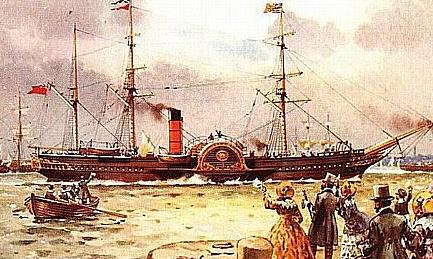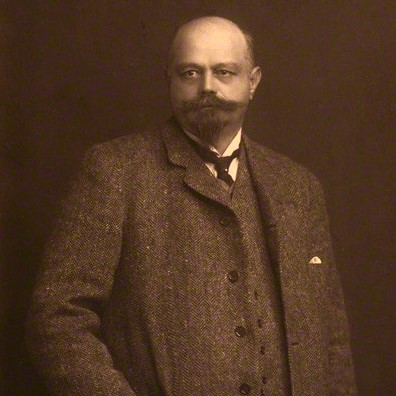The start of passenger ship interior design between the end of the 19th century up to World War I
During the mid nineteenth century travelling by ocean liner was seen as a highly uncomfortable and dangerous mode of transportation. A well-known example hereof is described by novelist Charles Dickens (1812 – 1870) when he boarded Cunard’s fist transatlantic steamer Britannia in 1842. He found his cabin to be an “utterly impractical, thoroughly hopeless and profoundly preposterous box”. In fact, Britannia with her length of 63 m and beam of 10m was quite a large ship in her time. She was one of the first vessels to be steam powered, marking the beginning of the commercial use of this new way of propulsion. It was during this era that wooden ships were substituted by iron and later steel vessels. Sailing ships became vessels driven by steam engines and later more efficient compound engines (from 1850) while paddlewheels were soon replaced by propellors.
The British reigned supreme on the high seas. Their passenger and combination (passengers and freight) liners serving the North Atlantic and their Australian and Indian colonies did not really face any competition at the time. However, this changed when during the mid 1890’s, Kaiser Wilhelm II ordered the start of a series of civilian (merchant shipping) and military (naval) projects to increase the presence of the German Reich on the world stage.
Liners developed into national icons at the end of the 19th century. Until then they were considered a dangerous way to travel as regularly one didn’t make it to its destination. However, to lure potential travelers, shipping lines had larger liners built with more facilities and more friendly interiors.
Now constructed of steel, this offered opportunities for larger and more luxuriously appointed interiors, attracting the rich to sail on their ships, bringing the shipping lines prestige and profit.

It soon became clear that specialized interior architects and designers as well as artists of name and fame were needed to accomplish this.
Starting in the 1880’s already, P&O relied on the services of Thomas Edward Collcutt (1840-1924) who had made name with his work on the Savoy Hotel in 1889 and the high-end Holborn Restaurant in 1894. They also worked with J.J. Stevenson (1831-1908). Both had ties with the Arts and Crafts movement.
British liners had held the Blue Riband (which is awarded to the ship making the fastest transatlantic crossing) for decades, but this changed overnight when the North German Lloyd from Bremen, Germany, introduced the Kaiser Wilhelm der Grosse in 1897. In 1901 Kronprinz Wilhelm followed. She also immediately snatched the Blue Riband from her predecessor.

When launching their first ocean-greyhound Kaiser Wilhelm der Grosse in 1897, North German Lloyd had Johann Georg Poppe (1837 – 1915) design her interiors. It was the first time one designer was made responsible for the interiors of an entire ocean liner. Lavish Neo-Baroque interiors were the result, heavily ornamented and overcrowded public spaces, exactly what Poppe was known for. He chose this Baroque revival style because it was immensely popular in Germany at the time and it indeed made Kaiser Wilhelm der Grosse a favorite with German passengers.
Hamburg Amerika Line, based in Hamburg was not to be outdone and her director, Albert Ballin ordered the Deutschland (1900). As expected she captured the Blue Riband from her North German Lloyd competitor. Sadly, she was plagued by severe vibrations and was later converted to a cruise ship. Hamburg Amerika from then on concentrated on luxury over speed.

Finally, after North German Lloyd had introduced the Kaiser Wilhelm II (1902) and Kronprinzessin Cecilie (1906) as the final vessels of the German four stacker quintet, the British answered to the challenge with the construction of Lusitania and Mauretania in 1906.
Already at the end of the 19th century, onboard the German four stackers operated by North German Lloyd and HAPAG Lloyd period styles could be found in the vessels’ interior design like the neo Baroque style Poppe had used for the smoking saloon on Kaiser Wilhelm der Grosse in 1897. This continued after the turn of the century and it even led to the use of a mixture of styles onboard a single ship. For example onboard the Compagnie Generale Tranatlantique’s France (1912) with her lavishly decorated interiors which made her an instant success on the transatlantic route. Empire, Louis XIV but also Oriental (Moorish) style rooms were connected by corridors decorated by wood-panelling with gilded ornaments and impressive columns.

Britain had not only seen Germany rise to naval supremacy, but also saw American business tycoon J.P. Morgan (1837 – 1913) expand his shipping empire at a rapid pace. He had taken over – amongst several others – the White Star Line, and the British Admiralty saw this as potential threat, the loss of additional shipping lines was simply out of the question. Apart from that, large liners could be used as troop transports should there be a war, and the growth of Germany becoming a major naval power was now all too obvious. So a loan was granted to Cunard for two first super liners which would outclass every liner in existence. Lusitania and Mauretania immediately captured the Blue Riband and Mauretania would keep it for an astonishing 23 years until the German liner Bremen seized it in 1929.
Mauretania‘s interiors were designed by Harold Peto who had her public rooms fitted out by London design house Ch. Mellier & Sons and Turner and Lord. Twenty eight different types of wood as well as high quality tapestries and marble were used. Her grand staircase was flanked by aluminium grilles, very modern at the time as were her elevators, also a novelty on a liner. Her first class public rooms boasted gorgeous wood panelling. A large dome skylight topped her multi-level first class dining room which was done in Francis I style (French Renaissance).
It had taken two decades to build larger and faster liners because technical issues like serious vibration when sailing at top speed had to be addressed first. The first company to order larger vessels than Lusitania and Mauretania was the White Star Line. Their famous trio of superliners Olympic, Titanic and Britannic boasted 45.000 gross tons against the Lusitania’s and Mauretania’s 31.500 gross tons. However, with these new ships, White Star now focused more on luxury than on speed. Alas, only the Olympic had a long and successful career as the Titanic was lost on her maiden voyage in 1912 after striking an iceberg and Britannic which had immediately taken up war service as a hospital ship in WWI struck a mine in Greek waters in 1916 being just a year old.
Olympic also was an example of an ocean liner where an array of interior styles was present like Queen Anne, Old Dutch, Louis XIV, XV, XVI as well as Italian Renaissance.
Now, Albert Ballin, director of the Hamburg Amerika Line stepped in and HAPAG ordered a trio of liners measuring around 53.000 gross tons able to accommodate 4600 pax. The first of the series was aptly named Imperator (1912), being the largest ship in the world at the time. The even larger Bismarck and Vaterland soon followed in 1913 and 1914 respectively.

Ballin had seen the work of interior architect Charles Fredric Mewes (1860-1914). Mewes had designed the Ritz Hotels both in Paris and London and he had modernized the Carlton Hotel in London in Beaux-Arts style. He was deeply impressed by the various 17th and 18th century Louis-styles and often worked with his junior partner Arthur Joseph Davis (1878- 1951). According to Davis there were a limited number of possible activities onboard the liners to keep passengers busy during a day at sea, so he wanted to design lively and interesting vessels by giving the public spaces onboard varying themes, preferably giving every room a different atmosphere.

Mewes and later Davis had started working on HAPAG’s Amerika of 1905 and later the Imperator (1912) where they designed the Tudor style Smoking Room which was decorated with brick from a demolished Tudor-era cottage in England and also the Pompeian style swimming pool in the same style as they had done for the Royal Automobile Club in London in 1908-1911. The pool was realised in a double-height space being surrounded by mosaic-decorated columns.
They also worked on Cunard’s Franconia (1911) and Laconia (1912) where, among others, they used a neo-classical style for the first class reading room. Cunard was impressed and contracted Davis to coordinate the interior design of their new flagship Aquitania of 1914. Again, as was usual in this era, she was a vessel with a mix of decorative styles in her public spaces. “The Ship Beautiful” as she was nicknamed boasted a first class lounge done in Baroque style honouring Christopher Wren (a highly acclaimed English architect, 1632–1723), emphasized by a red-carpet with a flowered pattern. Jacobean and Georgian styles were also used in the interior design of Aquitania.

In the period before WWI, P&O adopted a different approach, using colonial themes and materials onboard their ships, for example with the use of tiles which were a nod to the the Iznik polychrome ceramic tiles originating from the sixteenth-century Ottoman empire by leading arts and Crafts designer William de Morgan (1839-1917).
But things were about to change. Ballin’s Imperator again was an example of a combination of interior styles, but this time this caused a wave of criticism in Germany. Her mix of different Louis and Empire styles made one critic sigh that ”he wondered who the real emperor was here”. Clearly, German interior architects and artists had been overlooked (or ignored) to stay on the safe side to give Imperator international appeal. The influential cultural magazine Der Kunstwart launched a campaign against the lack of German national achievements onboard Imperator as did the Deutsher Werkbund (the assocation of German craftsmen). Both argued that there were enough examples of successful interior design by German architects and artists like Bruno Paul (1874-1968), Joseph Albrich (1867-1908) and Richard Riemerschmid (1868-1957). They had worked on the interiors of the Kronprizessin Cecilie of 1906, one of the famous quintet of German four-stackers of around the turn of the century, for example on the decoration of part of her cabins. Furniture, like the armchairs and salon tables by Riemerschmid had also been internationally praised. So North German Lloyd and in particular Ballin were heavily criticized for not having worked with German designers.

It was obvious that shipping lines wanted rich travelers to experience the same standards of service and interiors they were used to in venues like the high-end luxury Ritz hotels in London and Paris. For example the impressive light and airy Palm Court with its large skylight provided a model for Aquitania‘s interior as were the Louis XVI style hotel rooms.
However, it was now safe to say that passenger ships had come a long way: from the small diminutive Britannia of 1840. Of course technically, with their palational public spaces and top-level interior-design but as well considering the impeccable service offered on board. They were now deservedly called Floating Palaces. Indeed they matched the likes of e.g. the Ritz Carlton hotels but this was only true for a specific part of the vessel, namely first class, where the rich and famous bathed in luxury. Those who accounted for the largest share of the shipping lines’ revenues, steerage passengers, still travelled in the simplest of surroundings, albeit that circumstances below decks had vastly improved. When it became obvious that steerage passengers, emigrants, were slowly substituted by second class passengers, the new middle class consisting of teachers, doctors, business men and so forth, second class was expanded and dormitories were more and more replaced by two, four, six and even eight passenger cabins.
This was now the situation when WWI broke out, liner development came to a complete halt and the existing ships were one by one called upon for war duties.




